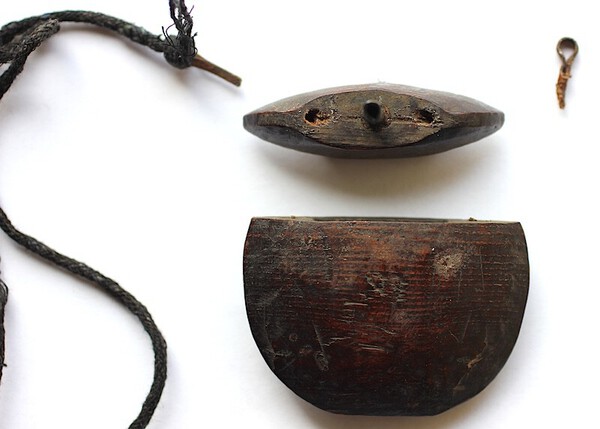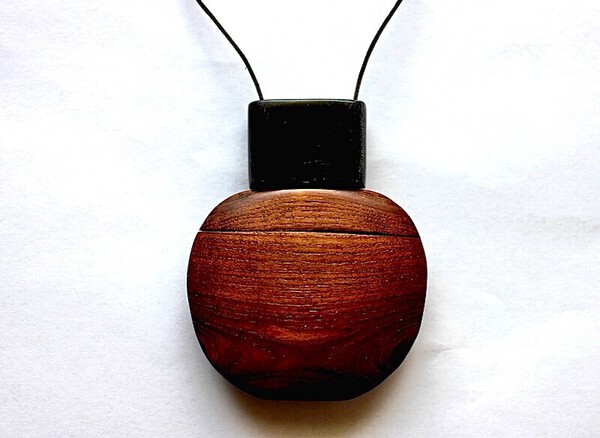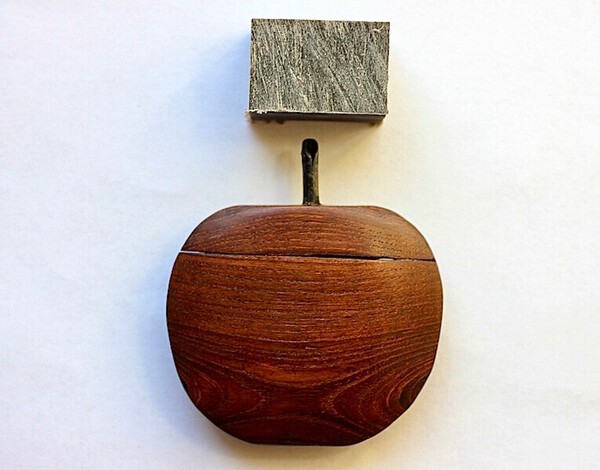-
Posts
516 -
Joined
-
Last visited
-
Days Won
3
Content Type
Profiles
Forums
Events
Store
Downloads
Gallery
Posts posted by Viper6924
-
-
Your latest project looks very nice, Piers. Nice balance between the different parts. It brings harmony to the whole piece 🙂
Jan
-
 1
1
-
-
Love your renovation of the flask. Before you could find genuine Edo-period flasks quite readily. These days it’s mostly ugly fakes.
I’ve also renovated some flask and it’s bloody hard work. Drilling all those holes are a nightmare. One time I had to start from scratch three times due to the fact that the holes didn’t line up.
Here’s a flask I rescued a couple of years ago. Cost me JPY1000. The cap was missing as well as the spout which was replaced by an iron pipe that was glued in place. The wooden flask was in an overall terrible state with a lot of damages on the wood.


It was only after I cleaned up the flask and discovered the nice wood grain that I realised why the original flask-maker chose this piece of wood to work with.The most rewarding thing is when you let go of the flask and the cap falls in place with a nice snap

Jan
-
 4
4
-
-
The Enamiya line is very well-known and I’ve seen many matchlocks made by several generation gunsmiths.
I have what we would label as a classic ”Sakai matchlock” with a signature beginning with Enami, which I think was part of the same line.
Do you have some pictures of the matchlock?
Jan
-
 2
2
-
-
A lot of info to process, Arthur
 New input on old ”ideas” are always welcome. When it comes to history, be it Japanese or other, we can’t afford to stop investigating. Otherwise stagnation sets in. Looking back at books written 10-15 years ago, reveals that the process of gaining new ground, indeed moves in the right direction. Albeit slow at times…
New input on old ”ideas” are always welcome. When it comes to history, be it Japanese or other, we can’t afford to stop investigating. Otherwise stagnation sets in. Looking back at books written 10-15 years ago, reveals that the process of gaining new ground, indeed moves in the right direction. Albeit slow at times…
When we comes to the topic about what is of Japanese true origin, the one important thing that comes to mind is Shinto. Apart from that, I like to think of the Japanese as the unrivaled masters at incorporating forriegn ideas. They tried and tested everything coming in from the mainland. Bad ideas not in par with the Japanese mindset, was discarded quicker than you can say sayonara. But if the ”import” took root in the heart of the locals, with locals I of course mean the top 1-2% of the community, assimilation and more importantly, development followed. We see this local improvement everywhere in Japanese culture. This is fact plain and simple.
Of course this also had an huge impact on the development of Japanese arms and armor development. Everything from the curve of a blade, horsemanship and general development of arms and armor came from abroad. But it was in many areas developed by the skillful Japanese artisans into something better and much more effective.
I have a 10 monme Kishu matchlock made in 1863. It’s the absolute pinnacle of perfection when it comes to matchlocks. Compare it to the western version would be like comparing a rusty bike to a Ferrari

It’s of course another question if this stubborn attachment to matchlocks was a sound policy, whilst the west was producing Winchester repeating rifles during the same period.
Nothing creates develpment like war. Nothing! Look at Ukraine. The locals brought in forreign technology in the form of harmless drones, which you can pick up in any tech-store for a few hundred dollars to spy on your neighbours and changed them into ”messangers of death” for the invaders. Just like the Japanese been doing for over a thousand years.
I will keep following this and other threads like it with great interest, as there are nuggets of gold within that will carry history forward.
So keep at it, Arthur 😉
Jan
-
 2
2
-
 1
1
-
-
Hi Björn!
There are no pictures. Can you try to resending them again.
Jan
-
You never know until you try it 🙂
I actually checked the matchlocks in my collection. Out of the 12, 6 had only plain holes for the mekugi. These 6 guns comes from all over Japan, so there’s no regional preference for one or the other.
Jan
-
 1
1
-
 2
2
-
-
Interesting way to secure the amaooi to the barrel. Not sure I’ve seen that before.
Otherwise an honest looking matchlock. Mid Edo period?
Jan
-
 1
1
-
-
This one looks very similar to a gun I recently had in my possession. I can bet a tiny beer that this specific matchlock carries a Sesshu (Sakai) signature. As Piers said, the kabuto decoration seems to be an indicator for Sakai.
To my eyes, the decoration on the barrel looks good. In there lies the mystery. Because often I find the quality of the inlayed barrels to be much better than some of the brass editions scattered all over the stock. Were the barrel decorations made independently from the brass works? Could some of them, like seen on this specific matchlock, been made during the original production or a later work dated from late Edo to the Meiji era?
Jan
-
 2
2
-
-
Hi Ian! Hope all is fine at your end of the world.
It’s funny, me and Piers have just instigated a conversation of our own regarding this very topic 🙂
You write that your Sakai got a Pine-decoration running underneath the stock. Have you checked the inside of the stock. Is there any cracks or old repairs running the length of the stock?
Jan
-
Solid-looking matchlocks, Robert. The first sports some Tabuse-school features and the other one Inoue-school.
When it comes to preserving the stock, I use Renaissance Wax for every matchlock in my collection. It gives the stock a pleasant shine and brings out the woodgrain in a nice way.
Plus, you only need to use this wax one time.
I put some wax on my fingertips and make sure to coat the stock. You only need to apply a thin layer. Then I wait a few minutes so the wax dry properly. As a finishing touch I use a piece of clean cloth with which I polish the stock. The harder you polish the more shine you get.I live in a modern house with central heating. The wax seems to protect the stocks from cracks, so no need to use oil.
Good luck!
Jan
-
 2
2
-
-
The placement of the kamon might support the notion that this indeed is a bukuro for an edged weapon like a naginata.
This crossed hawkfeather kamon, is placed so that the bukuro should be carried pointing up.
On most of the teppo bukuro I’ve encountered, the kamon is placed to facilitate the bukuro to be carried more or less horizontally (resting on your shoulder).Include a picture of a leather teppo bukuro were the kamon is placed according to the above description.
Whatever might be the case, it’s still a very nice bukuro.
Jan
-
 1
1
-
 1
1
-
-
Quite often they overlook the fact that the artifact comes with a date. On several occations I bought items labeled as 20th century by the seller. You have helped me with countless of these boxes. I’ve got a tabacco bon dated to 1840 and a Bamboo vase from 1811. I’ve bought these items for close to nothing. Something tells me that the seller would have upt his price if he knew that they carried that beautiful label ”Edo period”. Not that I complain 🙂🙂🙂
Jan
-
 1
1
-
 1
1
-
-
5 hours ago, Bugyotsuji said:
I realized again that boxes with characters on them attract me.
I can’t but agree with you on that 🙂
One thing that often surprises me is how Japanese sellers often ignore to mention characters present on boxes etc. I suspect that many of them can’t translate old-style Japanese.
To me added characters adds a lot of historical value.Jan
-
 4
4
-
-
It def got a ”projectile” shape to it. Is that a hole on top?
You find the strangest of things inside your barrels. I got 10+ matchlocks at home and the only thing I ever found was a piece of blackpowder-covered cloth in one of them 🙂Jan
-
 1
1
-
-
Now that’s what I call a flash in a pan 😂
Never seen so much ”content” down an old barrel.
Jan
-
 1
1
-
-
I think you got a lot of amazing ideas ”floating around in your cerebrum” 🙂
The 1580 mentioning of the melting down guns for bells are really interesting.
Keep digging, my friend!Jan
-
 2
2
-
-
Nothing beats the 30 monme matchlock from Yonezawa 👍
Just look at the amount of stuffed paper flying out from the barrel. That brings a lot of ”Umpf” 🙂🙂🙂
Jan
-
 1
1
-
-
Happy New Year, Ian! Good to hear from you.
First the Satsuma and now this 🙂Looks like an honest matchlock once owned by a proud samurai.
As it happens my first ever matchlock was a 3,5 monme matchlock made by the very same gunsmith as yours.
It’s not in top condition but it carries a Maeda-kamon which looks to be original to this gun. It might suggest that the gun was ”exported” to Kaga at one stage.
Isn’t matchlocks so much fun 🙂
Jan
-
 2
2
-
-
Late arrival to this post, but Piers has pretty much sorted out everything needed to be said about this matchlock.
Overall a very nice gun in good condition. Kunitomo-signed ”Kishu-style” matchlocks are indeed rather rare, as the majority of guns displaying such features (square-shaped fittings) were made in the Sakai/Osaka area.
I believe that the ramrod is the original one to this matchlock, which is always a big bonus in my book.
Beside sorting out the missing pancover and possibly trying to straightening out the serpentine, I would leave the gun as is.
A very good start to your matchlock collection 👍🙂Jan
-
 1
1
-
-
Thanks Brian! It was the ”log in” I missed 🙂
Jan
-
Where is this download? Can’t seem to find it. Or is it a IPhone thing, as I only use my phone.
Jan
-
I’ve already been in contact with Kelly 🙂
Jan
-
 2
2
-
-
A nice sized Bishamonten. As you say, it looks like a piece of folk art.
The flat back suggest that this statue orginally was housed in some sort of zushi.
Bishamonten is usually depicted either holding a small stick/club or a long spear. Depending on which, gives the statue different meanings.
I think you did well 🙂
Jan
-
 1
1
-
-
Amongst the huge collection at the Stibbert Museum in Florence, there is a matchlock that opens up just like a modern shotgun. I’ve only handled it for a few minutes, but if my memory doesn’t fail me, the gun was pretty much a standard-looking matchlock except for how it opened up. Was it a later modification or just a one-off? No idea. I just know that it’s the only one I’ve seen with such a feature.
Jan






Fresh out of the box!
in Tanegashima / Teppo / Hinawajū
Posted
I’m reading this 😂😂😂
We are about 240-250 A4 pages into this book project. It’s a massive project that needs to be done as the misinformation about Japanese matchlocks is quite scary.
Beside the editing part I think we need to write about 30-40 pages more in order to cover our bases.
So hopefully by the end of this year.
Jan